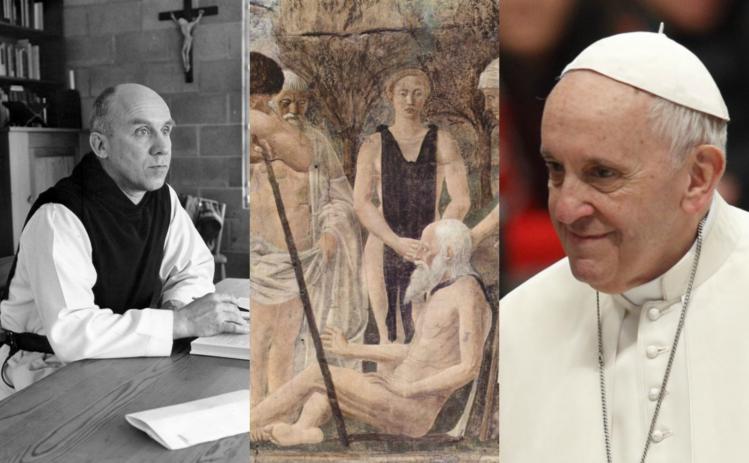
Every Thursday, look for our compilations of reader responses to articles that appear in print or online. This week, readers question the legacy of Pope Francis, trace the faith life of Thomas Merton, and more. Send your own responses to [email protected].
HAUNTED BY MERTON
Some men are mesmerized by rivers, spiritually and mystically. Biblically, water gives life and purifies our soul. Normal MacLean felt this same power. “Eventually,” he wrote, “all things merge into one. On some of the drops are timeless raindrops. Under the rocks are words, and some of the words are theirs. I am haunted by waters.”
I am haunted by Thomas Merton. Just as fishermen know that a river is never the same, my relationship with Merton morphs and bends, season by season, and year to year. This has been going on since 1968, when I was a junior in high school. The Seven Story Mountain nurtured my faith and showed me that a person with as powerful an intellect as Merton’s could reconcile science, the modern world, and faith in Christ. The recent collection of Merton’s articles by Commonweal editors (Thomas Merton at Commonweal) brought forth still another reaction to Merton in my spiritual life.
One of Merton’s biographers said that “there were many Mertons.” I’ve met many I like, some that leave me lukewarm, others that are, well, not so endearing. My favorite book of Merton’s remains The Sign of Jonas. It rings out clear as the Gethsemane Abbey bell. Merton writes about becoming a monk. It’s rich in Bible quotations and Merton’s desire to confirm his life to this book’s wisdom. His best writing of all, to me and many others, occurs in Firewatch, July 4, 1952: “You, O Christ….your compassion singles out and separates the one on whom Your mercy falls, and sets him apart from the multitudes.” Monkship is a singular profession.
There is a spiritual handbook Merton wrote in 1961, New Seeds of Contemplation. It has some practical chapters on topics such as contemplation, holiness, our body of broken bones, the moral theology of the devil, and many more. But it is in no way a cookbook or a rubric. Merton always understands that the experience of God runs beyond any words we use to describe it.
As a young person, Conjectures of a Guilty Bystander became my North Star. Merton danced with theologians (Barth and Bonhoeffer), drew from the womb of saints (Saint Paul, Saint Gall, Saint Thomas Aquinas), merged with philosophers (Maritain, Heisenberg, Marx) and the dominant problems of the time (racism, poverty, the threat of nuclear war). We continue to need new Mertons to help us with these terribly complicated problems. Conjectures was written in 1965, and his Christian faith came out loud and clear. More about this next.
Many books written in the 1960s, say some, indicate the broadening of his religious perspective, a fulfillment of Vatican II, and a positive and creative meld of Christianity and Buddhism. After reading Zen and the Birds of Appetite (1968), I could only sigh and say, “I just don’t get it.” Many others did get it and see this as perhaps the most creative aspect of his life.
There are seven books in the series The Journals of Thomas Merton, over two thousand pages, masterfully edited, a joy to read. Sadly to me, his Christian faith, so strong in the early volumes, seems to dissipate. For example, in Volume I, (counting by reading the indices), Christ is present on eleven pages and different aspects of God are discussed in fifty-seven topical ways. In the last volume, there is nary a mention of Christ and only eight discussion points on God. What has happened?
I am comforted by his recollections in the last year of his life. He continued to say the rosary and read his breviary (now called The Liturgy of the Hours). Perhaps the man who wrote so much about God entered into a relationship so deep that he was unable to write about it.
Within the past year or two, I’ve discovered More Than Silence: A Bibliography of Thomas Merton by Patricia A. Burton, daughter of his literary agent, Naomi Burton Stone. From typography to topics, it’s a gem, including prose works, poetry, translations of other authors, contributions to other books, visual arts, and even musical settings. There is a title finder of eighty-six pages (!) and an index of twenty-five pages. My task now is to deepen my understanding of Merton. It will be impossible to know him completely.
Thomas Merton has been a brother to me, one who is always there, a teacher and supporter, sometimes so hard to understand, but always a friend. He’s laid out my marching orders in the last sentence of The Seven Story Mountain: “That you may become the brother of God and learn to know the Christ of the burnt men.” These, of course, are the martyrs.
William Van Ornum
Poughkeepsie, N.Y.
DISRUPTION AND EMPOWERMENT?
The following are some observations regarding John Gehring’s article (“Five Years of Francis,” March 19). Regrettably, most of them are critical, but civility demands that I acknowledge having learned much from the author, and genuinely respect his robust, although flawed, defense of the “remarkable papacy” of Pope Francis.
That being said, it is not difficult to perceive the therapeutic intention with which the article begins. In the first paragraph, the reader is reminded that five years ago Pope Francis “immediately began changing the public face of Catholicism.” But what kind of makeover does the author have in mind? Apparently something more than a cosmetic nip-and-tuck is envisioned. Indeed, Gehring characterizes the onset of the papacy of Pope Francis as a “warning” to the Church to get over its “obsession” with opposing abortion, while, at the same time, striking a more “welcoming tone” toward LGBT people. Thus, the dawning of the age of Francis, we are to imagine, began with a curious blending of pop psychology and Latin-American tough love.
The second paragraph continues in this same vein, but, even more forcefully. And so, we are told that while Pope Francis was “disrupting” business as usual in Rome, he “empowered” a new generation of “Francis bishops” in the United States. Disruption and empowerment? Willful terms, not thoughtful ones; almost Nietzschean in tone, as if Pope Francis had somehow launched his papacy with a demonstration of the “will to power.” That is to say, with an exercise of papal persuasion for the purpose of forging a new (postmodern?) moral consciousness within a resistant, or timid, American Episcopacy. To what particular purpose, we should ask? Apparently, Gehring believes that it was meant to be a call-to-arms to that “new generation of Francis bishops…to speak out with renewed vigor on issues beyond abortion and birth control.” The author’s use of the word “beyond” in this context is inappropriate and misleading. I believe that the word “beside” would have been proper. There are, to be certain, other issues beside abortion, but there is simply no moral issue which is beyond abortion in its potential to utterly destroy the common good of a civilized society.
In paragraph three, the author seems to disclose the nerve of his argument. For there, he alleges that “the shift that Pope Francis is provoking” reflects a “substantial realignment” in the priorities of the “Catholic hierarchy.” Just how does the author imagine this “realignment”? Apparently, it takes the form of an open antagonism between Pope Benedict XVI’s eight-year papacy and the five-year papacy of Pope Francis. During the Benedict era, the author alleges that “bishops put most of their institutional weight behind lobbying against abortion and denouncing the contraceptive-coverage requirements in the affordable Care Act,” while “downplaying”, if not “entirely ignoring” traditional “Catholic social teachings on economic justice, workers’ rights, and health care.” Of course, it should be noted that the author makes all of these assertions rather glibly, while never mentioning and completely ignoring the teachings contained in the many documents on Catholic social teachings, published on a regular basis during the era of Pope Benedict by the NCCB. Instead, he seems content to scold the “more than eighty bishops” who, during the Benedict era, had nothing better to do with their pastoral time than to “rebuke” the University of Notre Dame “for inviting President Obama to give the commencement address” in 2009. In my opinion, this is also a quite misleading tactic on the part of the author; the eighty-three bishops who wrote in opposition to Notre Dame’s decision did so not simply for extending an invitation to the President to deliver the commencement address, but for conferring on him an honorary doctorate of Law degree. To their mind, it was one thing to invite the President to deliver an address, but it was something entirely different to bestow an honor which seemed to endorse his blatantly pro-choice position on abortion.
In paragraph four, the author gives a concise and clear account of the major social concerns of Pope Francis: such issues as the environment, especially climate change; the global economy; sensible gun reform; organized labor movements; living wages for workers; and collective bargaining. On all these issues, Gehring is informative and persuasive.
In paragraphs five, six, and seven, he takes up the growing phenomenon of the “small but vocal anti-Francis movement”; the “self-appointed guardians of orthodoxy.” According to the author, this curmudgeonly group of malcontents is “determined to squash anything that signals a resurgence of progressive Catholicism.” Furthermore, they seemed to have aligned themselves with another group of “wealthy conservative Catholics”, such as Tim Busch, John and Carol Saeman, and others who are also trying “to co-opt the pope’s teachings on economic justice that challenge free-market fundamentalism.” The author refers to them, rather snidely, as the “cigar-bar” crowd; the kind of Catholics, he claims, who want nothing to do with the “smell of the sheep.” Unfortunately, all of these characterizations are bristling with contempt.
Gehring concludes his article with some rather strong words of criticism against Pope Francis for “his woefully insufficient response” to the clergy abuse scandals which have devastated Catholic culture in our time. He maintains that unless Pope Francis is up to “the task of ensuring a zero-tolerance policy toward abusive priests,” then “the promise of his remarkable papacy will be lost.” One can only imagine how difficult, and painful, it must have been for Gehring to come to such a grim conclusion about his hero.
Bro. Owen J. Sadlier, OSF.
Cathedral Seminary House of Formation
Douglaston, N.Y.
OUT OF THE DITCH
Paul Baumann wrote an excellent review of Ross Douthat’s To Change the Church: Pope Francis and the Future of Catholicism (“A Precarious Unity?” May 4). Douthat’s position basically boils down to “don’t ask, don’t tell.” In a 2014 New York Times article, he wrote, “the formal teaching barring the remarried from communion coexists, inevitably, with individual choices that contravene the rule, and in the Western world especially many Catholics looking for straightforward laxity can very easily find what they are seeking.” Nothing to see here folks, just move along. People who want to take communion can find a way to do so, but just don’t say they can. The reason is the hidden tension between the lax and orthodox. If an attempt is made to resolve the tension in favor of the cafeteria Catholics, the “faithful” Catholics will have to leave; there will be an open schism instead of a hidden one. I don’t know if Douthat sees the irony in an exit by the “faithful” while the “unfaithful” remained through all those conservative popes. We’re all cafeteria Catholics; it’s just that “faithful” Catholics liked more of the menu until now. What are we left with if nothing changes? It’s all very clear.
The Church’s position is that marriage is indissoluble, except when it isn’t. Which may be okay, because that’s what Jesus said (in Mark), except when He didn’t (in Matthew). Mr. Baumann says that Matthew exercised his authority as an Apostle. But it’s not that. Matthew doesn’t exercise authority; he quotes Jesus as making an exception, although it’s not very clear to us what that exception is. Is it adultery or scandal? What kind of scandal? Jesus also says in Matthew, “Let anyone accept this who can.” What about those who can’t? The other early Apostles made no exceptions, except when they did (with Pauline and Petrine privileges).
There is, according to Baumann, the Brideshead option. You simply leave your current spouse and head back to the other. After all, it’s easy to leave your second spouse and children. They’d understand why you were leaving. Just tell them, “It’s not that I don’t love you, God made me do it.” No moral issue in abandoning them to return to the first spouse, who would always gladly take you back.
Annulments are clear. There’s no question as to whether it should be harder to get one (St. John Paul II) or easier (Pope Francis). No one questions that most Catholic marriages are valid, except Benedict and Francis. It’s quite easy to remember exactly what you believed about the indissolubility of marriage years later. No issue of whether, on top of a divorce, you’d want to revisit all that pain for yourself and ex-spouse in an annulment process. You would never really be able to get more than one, except when you can. No real problem for the children to have to go through an annulment after going through a divorce. It’s easy to understand that the children of the first marriage are legitimate even though they were born to a marriage that never existed. I’m not clear about children of the second, though. They were born to a marriage that doubly didn’t exist. If the remarried parents haven’t annulled, the children probably don’t have any problem with their parents “living in sin” and on their way to hell.
According to the Church, you can remarry as long as you live as brother and sister. It’s easy because it reduces marital fidelity to sex. Even if you marry someone else and love and support them financially, emotionally, and spiritually, those don’t count in the marital fidelity calculus. It’s all about sex. I’m not so clear whether desiring someone, but not doing anything about it, constitutes the lust in your heart that qualifies as adultery. That’s quite a tightrope Holy Mother Church is asking you to walk. I know I couldn’t do it.
Nope, nothing to see here. We should all just move along. Mr. Douthat is right that opening the door a crack will result in it being opened wider and wider. But as quoted above, he already knows it’s open a crack. I don’t know if Mr. Douthat recommends turning those who have found laxity in when they present themselves for communion, or reporting lax priests to the proper authorities.
There are many people trying to live morally: divorced, remarried, annulled, or trying to live as brother and sister. Marriage and divorce is not all black and white. It’s not as simple as saying one spouse is innocent and the other guilty. I think Merton said, “You and I are just fellow travelers along the road, fallen among thieves, trying to help each other up out of the ditch.” Would it really be so bad to try and do that? Francis seems to be willing to recognize institutionally what Mr. Douthat says is already happening. That small crack may be too much and Mr. Douthat may walk through it the other way, which would be a shame. As Mr. Baumann points out, there have been other cracks in other doors which became wide open. The Church survived those changes and it would survive this too. In the meantime, though, many more people would be helped up out of the ditch on their journey to God.
George M. Opsincs
Rochester, Minn.
Please email comments to [email protected] and join the conversation on our Facebook page.
Previous Story
Hipness & Humanity
Next Story
Household Names


